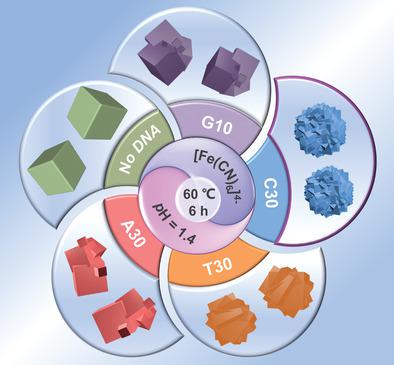当前位置:
X-MOL 学术
›
Adv. Funct. Mater.
›
论文详情
Our official English website, www.x-mol.net, welcomes your
feedback! (Note: you will need to create a separate account there.)
DNA-Dependent Prussian Blue Nanoflowers for Biosensing, Catalysis and Imaging
Advanced Functional Materials ( IF 18.5 ) Pub Date : 2022-12-01 , DOI: 10.1002/adfm.202208897 Dai Lu 1 , Hao Jiang 1 , Wenli Gao 1 , Shi Gang Liu 1 , Qian Zhao 1 , Xingbo Shi 1
Advanced Functional Materials ( IF 18.5 ) Pub Date : 2022-12-01 , DOI: 10.1002/adfm.202208897 Dai Lu 1 , Hao Jiang 1 , Wenli Gao 1 , Shi Gang Liu 1 , Qian Zhao 1 , Xingbo Shi 1
Affiliation

|
While shapes and surface properties of nanomaterials are known to play important roles in defining their properties, it remains challenging to fine-tune the morphologies systematically and predictably. Considering the extraordinary performance, prussian blue nanoparticles (PBNPs) are selected as the proof-of-concept nanomaterials. Herein, a DNA-dependence approach to fine-control the morphology of PBNPs via electrostatic interaction-mediated self-assembly of inorganic ions and protonated DNA is developed. The regulation of different DNA on the morphology of PBNPs is systematically investigated. 30-mer Oligo-C or -T (C30/T30) mediates formation of flower-like PBNPs (PB nanoflowers), whereas cubic structure with different sizes is observed in the presence of 10-mer oligo-G or 30-mer Oligo-A (G10/A30). Detailed mechanism studies indicate that the protonation of nucleobases is the key factor for the morphological evolution. C30-dependent PB nanoflowers are superior to PB nanocubes in photothermal properties, peroxidase mimetic activity, photo-Fenton catalytic performance, and light scattering property, which present 1.2-, 3.78-, 1.58-, 1.93-fold improvement, respectively. Furthermore, PB nanoflowers mediated by the diblock DNA (sDNA; comprising C30 and complementary strands of the target DNA) unexpectedly acquire biorecognition capabilities. This study opens a new avenue for the systematic and predictable synthesis of PB nanoflowers, which broadens the repertoire of PBNPs for catalysis, biosensing, and imaging.
中文翻译:

用于生物传感、催化和成像的 DNA 依赖性普鲁士蓝纳米花
虽然已知纳米材料的形状和表面特性在定义其特性方面起着重要作用,但系统地和可预测地微调形态仍然具有挑战性。考虑到非凡的性能,普鲁士蓝纳米粒子 (PBNPs) 被选为概念验证纳米材料。在此,开发了一种依赖于 DNA 的方法,通过静电相互作用介导的无机离子和质子化 DNA 的自组装来精细控制 PBNP 的形态。系统研究了不同DNA对PBNPs形态的调控。30-mer Oligo-C 或 -T (C30/T30) 介导花状 PBNPs(PB 纳米花)的形成,而在 10-mer oligo-G 或 30-mer Oligo- 存在下观察到不同大小的立方结构A(G10/A30)。详细的机制研究表明,核碱基的质子化是形态进化的关键因素。C30依赖的PB纳米花在光热性能、过氧化物酶模拟活性、光芬顿催化性能和光散射性能方面优于PB纳米立方体,分别提高了1.2倍、3.78倍、1.58倍、1.93倍。此外,由二嵌段 DNA(sDNA;包含目标 DNA 的 C30 和互补链)介导的 PB 纳米花意外地获得了生物识别能力。这项研究为 PB 纳米花的系统和可预测合成开辟了一条新途径,拓宽了 PBNPs 在催化、生物传感和成像方面的应用范围。C30依赖的PB纳米花在光热性能、过氧化物酶模拟活性、光芬顿催化性能和光散射性能方面优于PB纳米立方体,分别提高了1.2倍、3.78倍、1.58倍、1.93倍。此外,由二嵌段 DNA(sDNA;包含目标 DNA 的 C30 和互补链)介导的 PB 纳米花意外地获得了生物识别能力。这项研究为 PB 纳米花的系统和可预测合成开辟了一条新途径,拓宽了 PBNPs 在催化、生物传感和成像方面的应用范围。C30依赖的PB纳米花在光热性能、过氧化物酶模拟活性、光芬顿催化性能和光散射性能方面优于PB纳米立方体,分别提高了1.2倍、3.78倍、1.58倍、1.93倍。此外,由二嵌段 DNA(sDNA;包含目标 DNA 的 C30 和互补链)介导的 PB 纳米花意外地获得了生物识别能力。这项研究为 PB 纳米花的系统和可预测合成开辟了一条新途径,拓宽了 PBNPs 在催化、生物传感和成像方面的应用范围。包含 C30 和目标 DNA 的互补链)意外地获得了生物识别能力。这项研究为 PB 纳米花的系统和可预测合成开辟了一条新途径,拓宽了 PBNPs 在催化、生物传感和成像方面的应用范围。包含 C30 和目标 DNA 的互补链)意外地获得了生物识别能力。这项研究为 PB 纳米花的系统和可预测合成开辟了一条新途径,拓宽了 PBNPs 在催化、生物传感和成像方面的应用范围。
更新日期:2022-12-01
中文翻译:

用于生物传感、催化和成像的 DNA 依赖性普鲁士蓝纳米花
虽然已知纳米材料的形状和表面特性在定义其特性方面起着重要作用,但系统地和可预测地微调形态仍然具有挑战性。考虑到非凡的性能,普鲁士蓝纳米粒子 (PBNPs) 被选为概念验证纳米材料。在此,开发了一种依赖于 DNA 的方法,通过静电相互作用介导的无机离子和质子化 DNA 的自组装来精细控制 PBNP 的形态。系统研究了不同DNA对PBNPs形态的调控。30-mer Oligo-C 或 -T (C30/T30) 介导花状 PBNPs(PB 纳米花)的形成,而在 10-mer oligo-G 或 30-mer Oligo- 存在下观察到不同大小的立方结构A(G10/A30)。详细的机制研究表明,核碱基的质子化是形态进化的关键因素。C30依赖的PB纳米花在光热性能、过氧化物酶模拟活性、光芬顿催化性能和光散射性能方面优于PB纳米立方体,分别提高了1.2倍、3.78倍、1.58倍、1.93倍。此外,由二嵌段 DNA(sDNA;包含目标 DNA 的 C30 和互补链)介导的 PB 纳米花意外地获得了生物识别能力。这项研究为 PB 纳米花的系统和可预测合成开辟了一条新途径,拓宽了 PBNPs 在催化、生物传感和成像方面的应用范围。C30依赖的PB纳米花在光热性能、过氧化物酶模拟活性、光芬顿催化性能和光散射性能方面优于PB纳米立方体,分别提高了1.2倍、3.78倍、1.58倍、1.93倍。此外,由二嵌段 DNA(sDNA;包含目标 DNA 的 C30 和互补链)介导的 PB 纳米花意外地获得了生物识别能力。这项研究为 PB 纳米花的系统和可预测合成开辟了一条新途径,拓宽了 PBNPs 在催化、生物传感和成像方面的应用范围。C30依赖的PB纳米花在光热性能、过氧化物酶模拟活性、光芬顿催化性能和光散射性能方面优于PB纳米立方体,分别提高了1.2倍、3.78倍、1.58倍、1.93倍。此外,由二嵌段 DNA(sDNA;包含目标 DNA 的 C30 和互补链)介导的 PB 纳米花意外地获得了生物识别能力。这项研究为 PB 纳米花的系统和可预测合成开辟了一条新途径,拓宽了 PBNPs 在催化、生物传感和成像方面的应用范围。包含 C30 和目标 DNA 的互补链)意外地获得了生物识别能力。这项研究为 PB 纳米花的系统和可预测合成开辟了一条新途径,拓宽了 PBNPs 在催化、生物传感和成像方面的应用范围。包含 C30 和目标 DNA 的互补链)意外地获得了生物识别能力。这项研究为 PB 纳米花的系统和可预测合成开辟了一条新途径,拓宽了 PBNPs 在催化、生物传感和成像方面的应用范围。











































 京公网安备 11010802027423号
京公网安备 11010802027423号